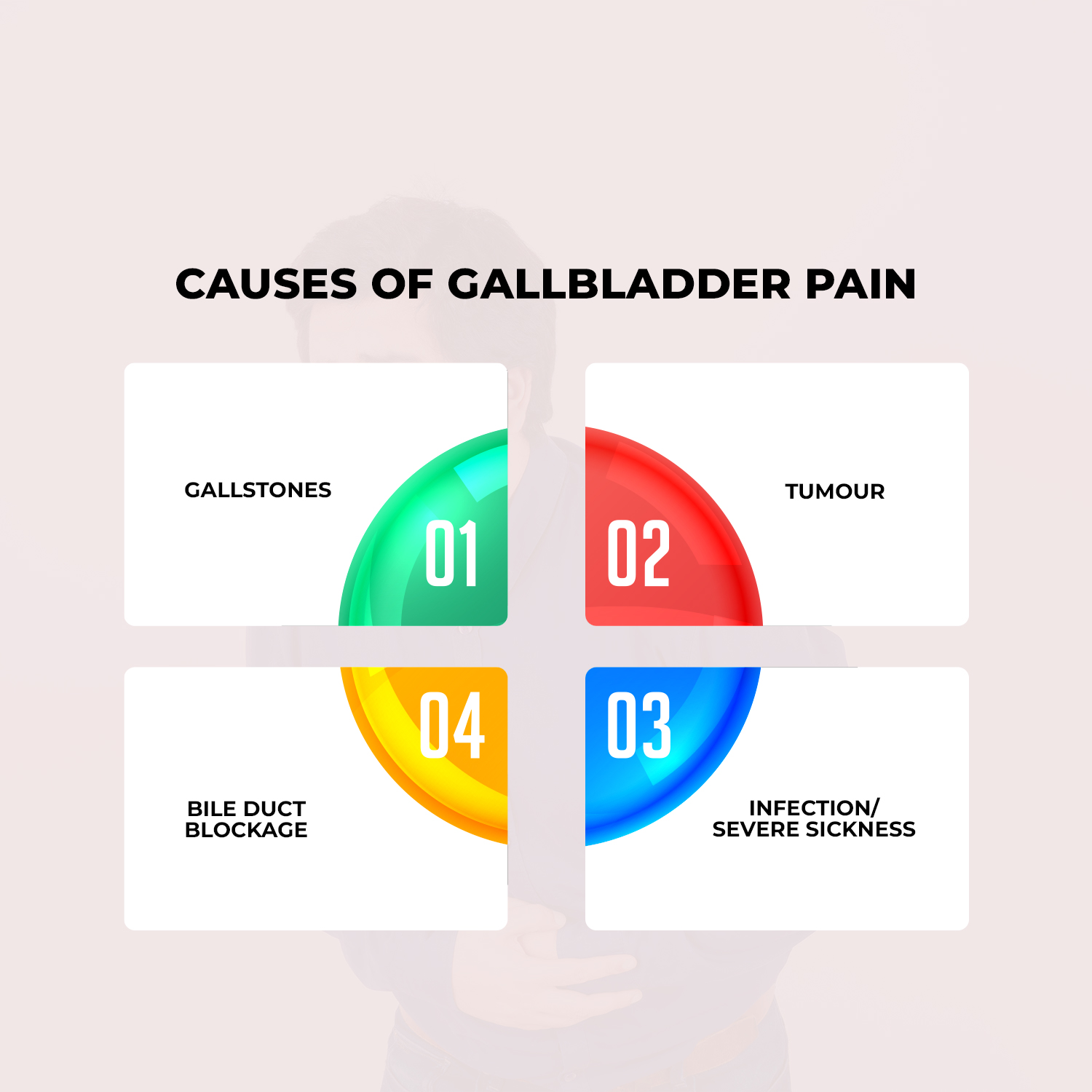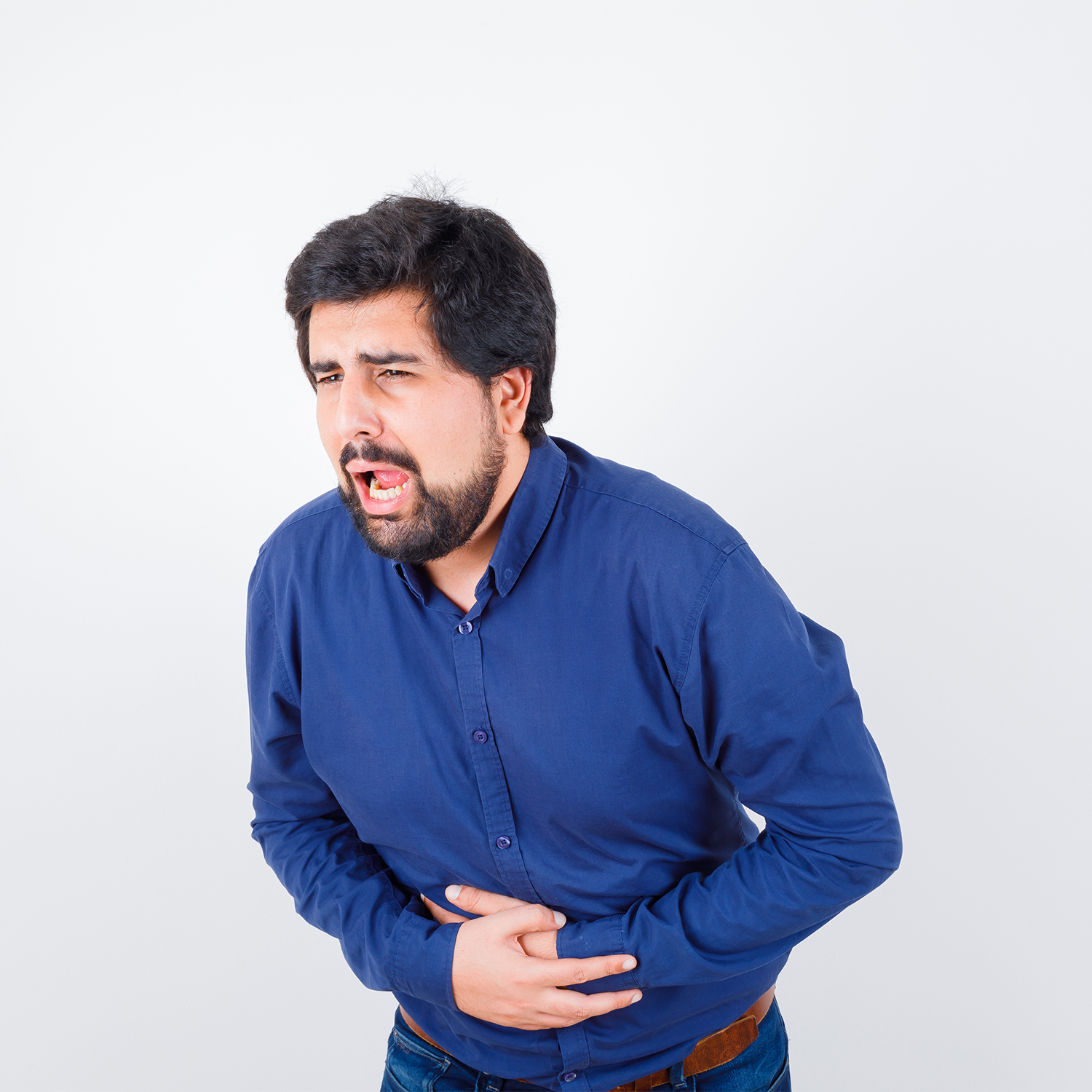Gallbladder pain also known as cholecystitis can be unbearable. If you have ever experienced one before, you will agree it is not a pain anyone should go through. The gallbladder is a small organ located at the upper right side of the abdomen. It functions as a catalyst that stores and releases bile when it is needed to facilitate the digestion process.
Table of Contents
When there is an interruption in the operation of the gallbladder, it hinders this organ from releasing bile when it is needed. The excessed stored bile becomes gallbladder stone which causes severe pain.
Causes of Gallbladder Pain

Causes of Gallbladder Pain
Gallbladder pain happens when the gallbladder is inflamed. That means the major cause of pain is gallbladder inflammation. Here are conditions that can cause gallbladder inflammation:
Gallstones
In most cases, gallbladder inflammation happens due to the presence of stones in the gallbladder. When bile is not released properly, hard particles are formed in the gallbladder. This could lead to blockage of the cystic duct. The cystic duct is the tract through which bile is transported to the small intestine. When it is not passed, it leads to inflammation.
Tumor
A tumor is the growth of an abnormal and unwanted mass tissue in a certain area of the body. When this growth occurs in the gallbladder, it can lead to blockage. Bile will build up in the gallbladder when there is no proper drainage and this will lead to inflammation.
Bile Duct Blockage
Bile duct blockage may happen as a result of stones or tiny particles in the duct. Also, when the bile becomes too thick it hinders proper drainage.
Infections/Severe sickness
AIDs and other viral infections can lead to gallbladder blockage. Also, certain illnesses when left untreated can trigger gallbladder inflammation. The blood vessels can become damaged as a result of serious illness. This can cause a decline in the amount of blood that flows to the gallbladder.
Symptoms of Gallbladder Pain
Symptoms of this illness may vary per person. Sometimes, the severity of the disease could lead to more serious symptoms. Some patients might not notice any serious symptoms until the disease becomes more severe.
However, certain conditions are peculiar to gallbladder pain. The patient may experience the following symptoms:
- Nausea
- Vomiting
- Fever
- Serious abdominal pain. The pain could be on the upper right or center of the abdomen. Some patients suffering from gallbladder pain also complain of pain in their right shoulder and back.
In most cases, you might not notice any symptoms until after the meal.
Risk Factors of Gallbladder Pain
Specifically, gallbladder stones are the major cause of gallbladder pain. This pain can lead to other health complications such as
Infections in The Gallbladder
Continuous inflammation of the gallbladder can lead to pain. If this persists without treatment, it can cause an infection within the gallbladder. An infection in the gallbladder can lead to other severe health complications.
Death of Gallbladder Tissue
When cholecystitis is left untreated, it can lead to the death of gallbladder tissue. This complication is most common among old people and those who suffer from diabetes. This condition can lead to the tearing or bursting of the gallbladder.
How To Prevent Gallbladder Pain
In most cases, prevention is always better than cure. To reduce the risk of having gallbladder pain, you can do the following:
1. Maintain Moderate Weight
Obesity could increase the chance of developing gallbladder stones. The best way to stop this from happening is by maintaining a moderate weight. If you are overweight, you may consider losing weight by indulging in a series of physical activities. Also, you must reduce calories by eating healthily.
2. Eat Healthily
You may need to speak with your dietician to devise a proper meal plan. Food with high fat can increase the chance of developing gallstones. Also, food low in fiber may boost the chances of developing gallstones. Instead, you should eat more fruits and Vegetables.
Diagnosis
Once you notice any of the symptoms explained in the content of this article, you should see your healthcare provider. Other underlying health issues might be the cause of your symptoms. The best way to ascertain the cause of the symptom is through proper diagnosis.
Your healthcare provider will study your medical record and conduct a physical examination on you. Here is some method of diagnosis of cholecystitis:
Blood Test
A blood test is to look for infection or other signs of gallbladder problems. This test is most efficient if your health provider suggests that your condition might be caused by an infection.
Imaging Test
This kind of imaging test shows the gallbladder. This imaging test could come in the form of (a CT) scan, abdominal ultrasound, endoscopic ultrasound, (MRCP) magnetic resonance cholangiopancreatography or endoscopic ultrasound. These imaging tests would show the gallbladder and bile ducts. If there are stones in the gallbladder, this test would see them.
Scan Test
A scan test might be advised. This test is called hepatobiliary iminodiacetic acid (HIDA). It shows how bile moves from the liver to the small intestine. With this, a problem can be detected through the scan. Before the test, a radioactive dye is injected into the body. When the test commences, the dye can be seen on the screen as it moves with the bile through the ducts. This image can show if there is any blockage in the bile duct.
When To See A Doctor
You should see your healthcare provider immediately if you discover you are experiencing any gallbladder pain-related problems. Even if the pain is mild and has gone away, do not take chances, see your healthcare provider immediately. You will be examined to ensure that you don’t suffer more gallbladder pain consequences in the future.
Also, numerous other underlying health conditions have similar symptoms. While you can’t ascertain what is causing the pain, your healthcare provider can. And they can tell you through diagnosis what exactly is wrong and what medication to take.
You should seek urgent medical attention if you notice any of these symptoms:
- Coloured urine
- Nausea
- Coloured stool
- Fevers and chills
- Yellow or pale skin
Gallbladder Pain Treatment
Treatment for gallbladder pain depends on its cause of it. In some cases, patients who are not showing symptoms might be asked to wait it out. Surgery might be done if symptoms start showing. However, only a few patients with gallstones show symptoms.
Other times, healthcare providers may prescribe some medications. In most cases, medication for gallbladder pain is a nonsteroidal anti-inflammatory (NSAID) to stop inflammation and reduce the pain. Also, antibiotics could be recommended if the doctor suspects that the disease could be caused by an infection.
Whatever the form of medication is, patients might become addicted to them.
7 Natural Remedies to Overcome Gallbladder Pain

7 Natural Remedies to Overcome Gallbladder Pain
Natural remedies are the best alternative approach to managing gallbladder pain. It is, however, advisable to check in with your doctor to know the best natural remedy method you can adopt. We will highlight seven natural remedies to overcome gallbladder pain below:
1. Exercise
One of the most effective ways to naturally overcome gallbladder pain is through regular exercise. Having known that being overweight increases the chances of developing gallbladder stones, regular exercises can help put your weight in check.
Research has proven that regular exercise helps reduce the level of cholesterol in the body. And when the cholesterol level is reduced, the chances of developing gallbladder are also reduced. According to the National Institute of Diabetes and Digestive and Kidney Diseases, 150 minutes of moderate physical exercise weekly can control excess fat in the body.
Just before you jump on any form of exercise, it is important to know that some physical activities can cause abdominal pain. You should consult your health provider for recommendations of exercise that best fits your needs.
2. Good Diet
A poor diet can cause more harm to the body than we know. For instance, excess intake of food containing sugar and fat can increase the possibility of growing gallbladder stones. Fatty foods are difficult to break down in the body and this can cause serious abdominal pain.
Meanwhile, food rich in fibre can help decrease the chances of developing gallbladder stones. We strongly advise that you consult your dietician to devise a proper meal plan that will help combat the possibility of developing gallbladder stones. For recommendations, you should eat more of the following foods:
- Whole grains
- Nuts
- Fish
- Brown rice
- Beans
- Fruits and vegetables
Your dietician will enlighten you on how to take these foods in the right proportion.
3. Turmeric
Turmeric contains curcumin properties, a perfect supplement for relieving inflammation. This can be used to treat numerous health conditions.
Gallbladder pain occurs when the bile is not emptied properly. What turmeric does is enhance the bike to empty to stop inflammation. One of the ways to use turmeric is by adding it to your meal. Also, it can be added to the drink.
We advise that before you make a decision, check in with your doctor to know the appropriate dosage to avoid unpleasant reactions.
4. Use Cider Vinegar
Applying cider vinegar is a natural anti-inflammatory supplement to relieve gallbladder pain. Raw apple is made of anti-inflammatory properties that make it suitable for use in this condition.
For treatment, get warm water and pour two spoons of apple vinegar. Mix it well and drink this gently until the pain is reduced.
5. Heated compress
When experiencing pain from gallbladder inflammation, heat can help suppress the spasm. During inflammation, there is pressure from the bile duct. Applying heat to the affected area can help relieve this pressure and reduce the pain.
To do this, soak a cloth or towel in warm water, place the towel on the affected region and apply pressure for about 10 minutes. This process is safe. You can do it repeatedly until you are relieved.
6. Magnesium
Magnesium is contain perfect supplements that can help reduce spasms and pain in the gallbladder. When the body lacks the appropriate dosage of magnesium, it can boost the possibility of developing gallstones.
Mix two teaspoons of magnesium in warm water. You can drink this daily. It will help manage gallbladder pain.
7. Apply Peppermint tea
Peppermint tea can relieve pain from gallbladder stones. Peppermint is made with menthol which is good for pain relief. This condiment also works perfectly for nausea, stomach pain and other forms of discomfort in the stomach region.
To control gallbladder pain, you should drink peppermint tea regularly.
Conclusion
Although there are other medical ways to treat gallbladder pains, however, most of them are addictive. This means patients might not be able to live a comfortable life without them in the long run. That’s why natural remedies are considered the best choice.
If you are experiencing gallbladder pain, you may adopt the natural remedies explained in the content of this article. We strongly advise you to check in with your health provider to know the best natural remedy that best works for you.
Post Disclaimer
The information contained in this post "7 Natural Remedies to Overcome Gallbladder Pain" is for educational purposes only. Always consult your primary care doctor before using the remedies that are provided. The information is provided by The Hidden Cures and while we do timely, in-depth research on the information that we provide to you, everything stated may not be up to date or accurate from the time it was written.
